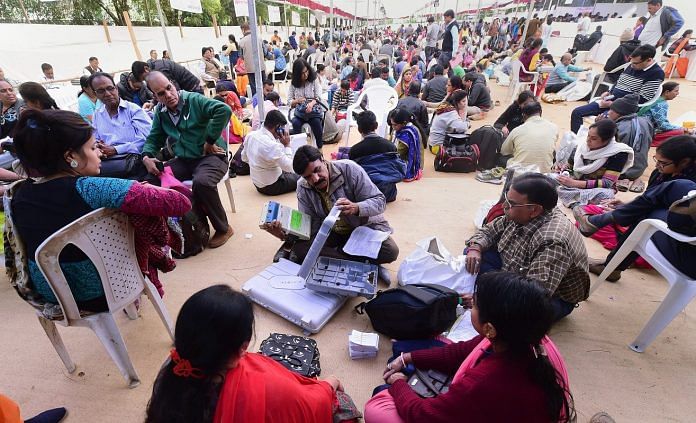Modi’s popularity and the much touted Gujarat model will be pitted against the Congress’ narrative of change and its carefully planned caste experiment.
Ahmedabad: Ninety-three constituencies across 14 districts vote in the second and final phase of the high-stakes Gujarat assembly election Thursday, drawing the curtains on what has been a frenzied and ruthlessly competitive election season.
From Pakistan to a seaplane, the controversial campaign for this phase saw Prime Minister Narendra Modi tick all his boxes, and some more. Modi played both victim and incumbent as it suited him, riding on the twin themes of identity and development.
Congress president-elect Rahul Gandhi, meanwhile, focused on pointing holes in Modi’s ‘vikas’ model, while calling for change that would usher in “non-divisive politics”, campaigning extensively across the region and leading the party’s charge.
It’s ‘Congress Ave Che, Navsarjan Lave Che’ (Congress is coming to power, ushering in a resurgence) versus BJP’s ‘Hu Chu Vikas, Hu Chu Gujarat’ (I am development, I am Gujarat).
Thursday’s final battle will be between the BJP’s formidable organisation machinery, Modi’s high popularity and the state’s much talked about development model against the Congress’ narrative of change and its carefully planned caste experiment.
While 19 districts in the Saurashtra and South Gujarat region polled on 9 December, the districts in the central and northern part of the state will vote Thursday.
Of the 93, BJP holds 52 and Congress 39 seats. The votes are due to be counted on 18 December.
ThePrint, in this leg of reporting, travelled to districts such as Banaskantha, Sabarkantha, Patan, Ahmedabad, Anand, Khera, Panchmahal, Mehsana and Vadodara.
The BJP is seen to be vulnerable on account of 22 years of incumbency and policy decisions such as demonetisation and GST. The Congress has challenged Gujarat’s ‘vikas’ model and harped on its “failures” at the Centre, calling for a change.
The big issue yet again will be the impact of the Patidar agitation, with Mehsana at the heart of it. Deputy chief minister Nitin Patel’s seat, Mehsana City, continues to witness widespread anger against the BJP over the Patidar issue, while a sizeable section of the community in rural areas seems more tilted towards the party.
In north Gujarat, the Congress holds greater sway than the BJP. In Banaskantha, for instance, the BJP has only three of the nine seats while in Sabarkantha, it has just one MLA in the Idar constituency. The party would need to increase its tally in this region if it wants to comfortably reach the finishing line.
It is hoping to reap electoral benefits of what it believes to be “prompt and efficient” relief and rehabilitation work in the flood-affected areas of this region. Bringing in the Narmada water to dry areas has also been a key election pitch.
The Congress, meanwhile, has to hold on to if not better its performance, in north Gujarat to keep its hopes of defeating BJP alive.
Ahmedabad district, with its 21 seats, is crucial. The BJP has 17 while the Congress has four MLAs here. It does seem, however, that the BJP’s urban base remains largely intact.
The tribal community in this phase is also significant, dominating districts like Panchmahal, Dahod and Chhota Udaipur. Traditionally a Congress base, the BJP seems to have made slight inroads here.
Two interesting seats to watch out for will be Radhanpur and Vadgam. OBC leader Alpesh Thakor, who recently joined the Congress, is contesting in Radhanpur and Dalit leader Jignesh Mewani in Vadgam.
This rainbow coalition of Thakor, Mewani and Patidar leader Hardik Patel is a crucial gamble by the Congress and the ability of Thakor and Mewani to win their seats will determine whether it really paid off.
While Hardik isn’t contesting the election himself, the impact of the Patidar protests that he spearheaded will be key to his political future. There is little doubt that Hardik has indeed managed to rally a huge section of the Patidar youth behind him, but how effectively this translates into electoral gains for the Congress will be known on 18 December.






